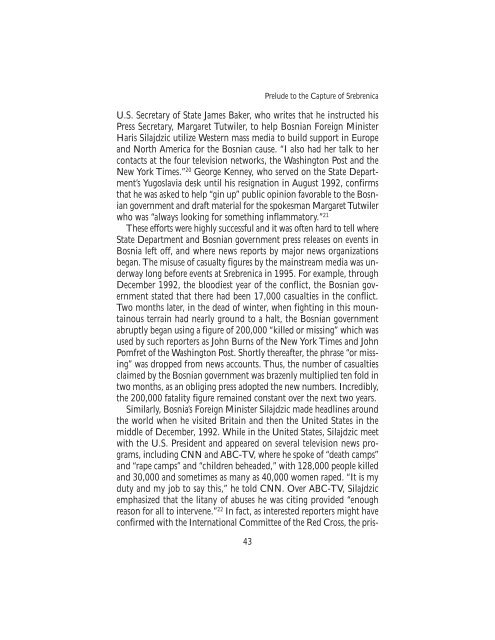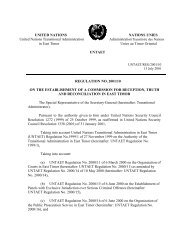The Srebrenica Massacre - Nova Srpska Politicka Misao
The Srebrenica Massacre - Nova Srpska Politicka Misao
The Srebrenica Massacre - Nova Srpska Politicka Misao
Create successful ePaper yourself
Turn your PDF publications into a flip-book with our unique Google optimized e-Paper software.
Prelude to the Capture of <strong>Srebrenica</strong><br />
U.S. Secretary of State James Baker, who writes that he instructed his<br />
Press Secretary, Margaret Tutwiler, to help Bosnian Foreign Minister<br />
Haris Silajdzic utilize Western mass media to build support in Europe<br />
and North America for the Bosnian cause. “I also had her talk to her<br />
contacts at the four television networks, the Washington Post and the<br />
New York Times.” 20 George Kenney, who served on the State Department’s<br />
Yugoslavia desk until his resignation in August 1992, confirms<br />
that he was asked to help “gin up” public opinion favorable to the Bosnian<br />
government and draft material for the spokesman Margaret Tutwiler<br />
who was “always looking for something inflammatory.” 21<br />
<strong>The</strong>se efforts were highly successful and it was often hard to tell where<br />
State Department and Bosnian government press releases on events in<br />
Bosnia left off, and where news reports by major news organizations<br />
began. <strong>The</strong> misuse of casualty figures by the mainstream media was underway<br />
long before events at <strong>Srebrenica</strong> in 1995. For example, through<br />
December 1992, the bloodiest year of the conflict, the Bosnian government<br />
stated that there had been 17,000 casualties in the conflict.<br />
Two months later, in the dead of winter, when fighting in this mountainous<br />
terrain had nearly ground to a halt, the Bosnian government<br />
abruptly began using a figure of 200,000 “killed or missing” which was<br />
used by such reporters as John Burns of the New York Times and John<br />
Pomfret of the Washington Post. Shortly thereafter, the phrase “or missing”<br />
was dropped from news accounts. Thus, the number of casualties<br />
claimed by the Bosnian government was brazenly multiplied ten fold in<br />
two months, as an obliging press adopted the new numbers. Incredibly,<br />
the 200,000 fatality figure remained constant over the next two years.<br />
Similarly, Bosnia’s Foreign Minister Silajdzic made headlines around<br />
the world when he visited Britain and then the United States in the<br />
middle of December, 1992. While in the United States, Silajdzic meet<br />
with the U.S. President and appeared on several television news programs,<br />
including CNN and ABC-TV, where he spoke of “death camps”<br />
and “rape camps” and “children beheaded,” with 128,000 people killed<br />
and 30,000 and sometimes as many as 40,000 women raped. “It is my<br />
duty and my job to say this,” he told CNN. Over ABC-TV, Silajdzic<br />
emphasized that the litany of abuses he was citing provided “enough<br />
reason for all to intervene.” 22 In fact, as interested reporters might have<br />
confirmed with the International Committee of the Red Cross, the pris-<br />
43



